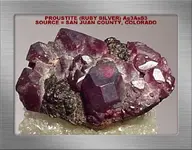Hi Jim,
After Garrett viewing this video they informed me that the "Discrimination/Pulse-Delay functions of the ATX and the Infinium are effectively the same and The ATX's Iron Check button, on the other hand, does not use this delay method at all. Rather, it uses a completely different/independent circuit to determine if the target is ferrous or not."
knowing this, I will use this more as well as incorporating it with the ATX's iron check button for a double wammy on target id.
Thats pretty cool eh Jim...
Alan
Way cool… definitely a double whammy that adds to the ATX’s capability. But I think that some readers / viewers will be confused about when and how to use the discrimination feature while prospecting Al, so below is a summary about how I use it here in the silverfields. The bottom line is that for general searching in most areas it should not be used except to check questionable target signals. BTW... I stick to Infinium’s mono coils, they tend to handle iron better than the DDs.
Regardless of ground mineral conditions encountered in Ontario’s silver country to date, I’ve found that any silver ores, quantities of iron trash, and other non-ferrous targets at or below the zinc penny GB position will
produce a low conductive high-low signal both in zero discrimination and in maximum discrimination. Many zero discrimination low conductive signals will lose some or all their signal strength in maximum discrimination. Such signal strength loss in max discrimination mostly depends on the physical / conductive traits of the target, and with target depth. All such signals must be dug, and unfortunately
these do include small or flat low conductive iron that typically resides in the VLF iron range.
Targets above the zinc penny GB position
will produce a high conductive low-high signal in zero discrimination. These include much rarer high conductive silver, and plenty of larger iron that is always present in mining areas. For example… larger drill bits and milling balls, drill rods, implements, rail spikes, and most nails. A good portion of this iron resides in the non-ferrous range of a VLF target ID, or bounces between iron and non-ferrous readouts. In excessively trashy areas you can ignore zero discrimination low-high signals and eliminate digging considerable iron. But you will also eliminate any chance of finding occasional high conductive silver.
On the other hand, lets say we acquire a low-hi zero discrimination signal, but want to check it in maximum discrimination to see if it could be high conductive silver. If it switches to a high-low signal in max discrimination, we know the target resides in a GB range from zinc penny to silver dime inclusive. It could be silver but the odds always favor that it is iron… its your decision whether to dig. Generally in this range, although depth is a big variable, iron retains more signal strength than do silver ores, so if the signal volume decreases significantly or disappears altogether… dig the target without fail.
If the signal remains a low-high signal in max discrimination… indicating a GB point beyond the silver dime GB position… you can ignore it because it will prove to be iron in my area. Naturally occurring native silver here… our silver ranges from foil to silver dime conductivity… will not produce a low-high tone in reverse discrimination in my experience. Although such silver possibly exists, it is so extremely rare as to not warrant consideration as a practical detecting matter.
But conditions can and do vary in other locations. We need look no further than Michigan’s Upper Peninsula, a source of high purity copper specimens that commonly produce high conductive VLF target ID readouts in the quarter to half-dollar range. These specimens do produce a low-high signal both in zero and reverse discrimination. Perhaps the same could apply to silver and gold elsewhere… one shouldn’t totally discount that possibility, nor forget that no discrimination system is infallible.
I’ve described in the above post my view of how the ATX / Infinium discrimination control works (adjustable pulse delay that correspondingly shifts the relative GB position). In a strictly prospecting context, other than searching conductive wet salt environs or sites dominated by coke–slag-cinder-ash mixtures that are occasionally encountered in mining camps,
the discrimination control should be left at the most sensitive minimum position for general searching in prospecting applications. Learn to identify occasional hotrocks that beep and ignore them if you can, otherwise one can use the ground balance feature to deal with hotrock patches if necessary. Some hotrock types may also respond to the ATX’s “iron check” feature as demonstrated in an earlier video.
Final comment Al to do with the video. The iron check should work for shallow nails and so forth to maybe four or five inches… and most nails and small iron tend to be shallow. While I doubt it will identify deeper larger iron, for example a drill rod down a foot or more… the discrimination feature ought to identify such iron as low-high signals in both zero and maximum discrimination. At the very least, I’d be happy if the iron check can identify some of the small iron that produces diggable low conductive high-low signals.
It would have been good to run the iron check over the first nail that produced a high-low signal in the video. And ditto for that rusty sheet metal piece that also produced a high-low signal. Do you suspect or think the iron check feature is a VLF circuit? Thanks Al… it’s a real pleasure to speak with you… but no more lengthy posts from me… scout’s honor!!!

Jim.

